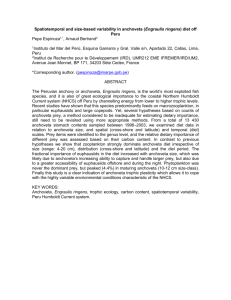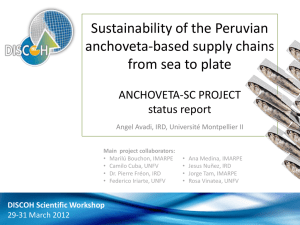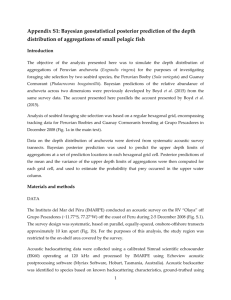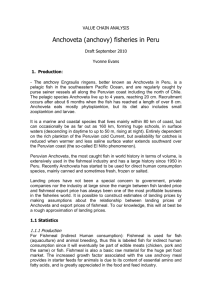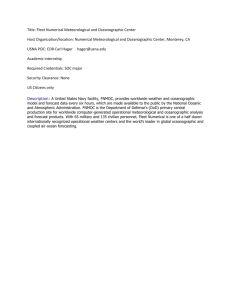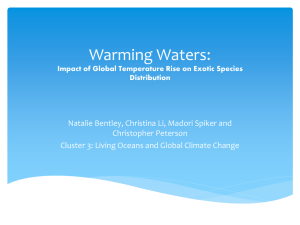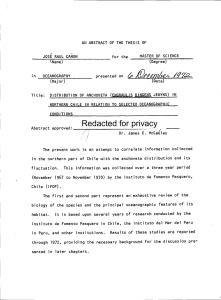LongW
advertisement
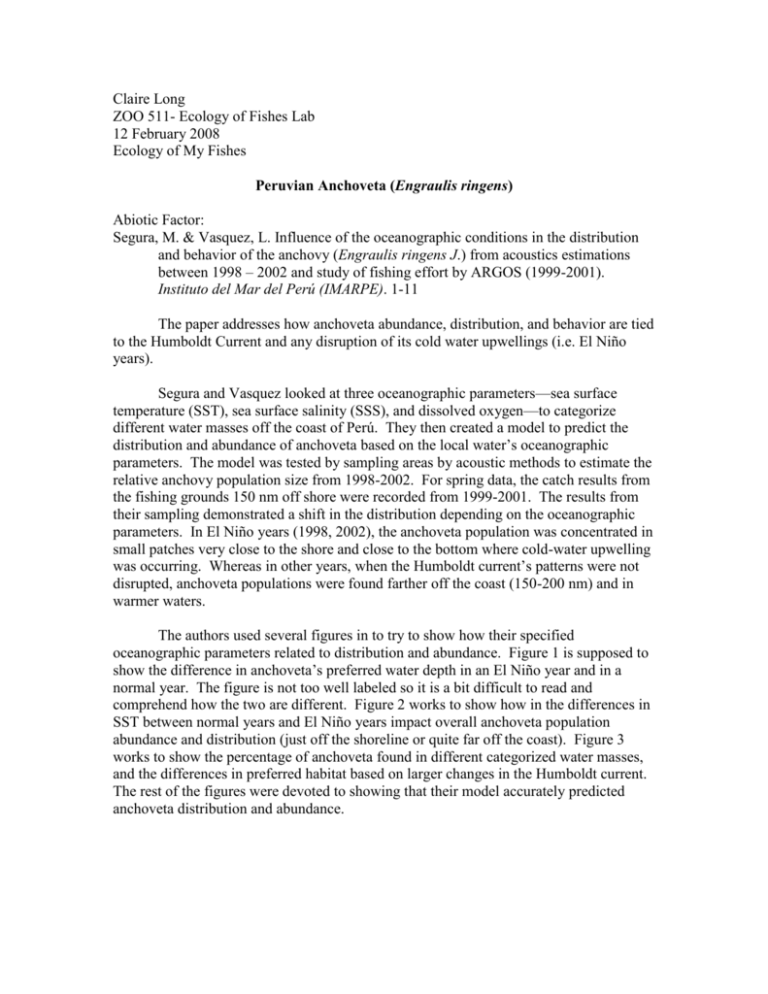
Claire Long ZOO 511- Ecology of Fishes Lab 12 February 2008 Ecology of My Fishes Peruvian Anchoveta (Engraulis ringens) Abiotic Factor: Segura, M. & Vasquez, L. Influence of the oceanographic conditions in the distribution and behavior of the anchovy (Engraulis ringens J.) from acoustics estimations between 1998 – 2002 and study of fishing effort by ARGOS (1999-2001). Instituto del Mar del Perú (IMARPE). 1-11 The paper addresses how anchoveta abundance, distribution, and behavior are tied to the Humboldt Current and any disruption of its cold water upwellings (i.e. El Niño years). Segura and Vasquez looked at three oceanographic parameters—sea surface temperature (SST), sea surface salinity (SSS), and dissolved oxygen—to categorize different water masses off the coast of Perú. They then created a model to predict the distribution and abundance of anchoveta based on the local water’s oceanographic parameters. The model was tested by sampling areas by acoustic methods to estimate the relative anchovy population size from 1998-2002. For spring data, the catch results from the fishing grounds 150 nm off shore were recorded from 1999-2001. The results from their sampling demonstrated a shift in the distribution depending on the oceanographic parameters. In El Niño years (1998, 2002), the anchoveta population was concentrated in small patches very close to the shore and close to the bottom where cold-water upwelling was occurring. Whereas in other years, when the Humboldt current’s patterns were not disrupted, anchoveta populations were found farther off the coast (150-200 nm) and in warmer waters. The authors used several figures in to try to show how their specified oceanographic parameters related to distribution and abundance. Figure 1 is supposed to show the difference in anchoveta’s preferred water depth in an El Niño year and in a normal year. The figure is not too well labeled so it is a bit difficult to read and comprehend how the two are different. Figure 2 works to show how in the differences in SST between normal years and El Niño years impact overall anchoveta population abundance and distribution (just off the shoreline or quite far off the coast). Figure 3 works to show the percentage of anchoveta found in different categorized water masses, and the differences in preferred habitat based on larger changes in the Humboldt current. The rest of the figures were devoted to showing that their model accurately predicted anchoveta distribution and abundance. Biotic Factor: Valdivia, I. M., Chávez, R. A., Oliva, M. E. (2007). Metazoan parasites of Engraulis ringens as tools for stock discrimination along the Chilean coast. Journal of Fish Biology 70: 1504–1511 This paper discusses how the presence (or absence) of specific parasites are used to distinguish between a northern and a southern anchoveta stock in Chile. The authors sampled six different Chilean ports covering 18º latitude and collecting 359 samples. The fish were then examined for ectoparasites and endoparasites. Six parasite species were found on the fish. However, the samples caught in the south lacked two parasites Pseudanthocotyloides heterocotyle and the copepod Caligus sp. The southern samples were correlated with the presence of Anisakis sp. This paper is interesting because it is one of the only papers that proposes that fish stocks can be differentiated by looking at the sample’s parasites. Valdiva et. al used their figures and tables well in the paper. Figure 1 is a map of Chile showing the six different sampling sites, which helps to distinguish the northern localities from the southern ones. Table 1 shows the average lengths of the fish caught at the different ports. This is useful because this data is later used in a multivariate ordination to support a differentiation in a northern Chilean stock from a southern Chilean stock. The data from Table 2(the prevalence and intensity of infection of a specific parasite species at each location) is also in the multivariate ordination (Figure 2). Tilapia (Oreochromis sp., Sarotherodon sp., Tilapia sp.) Abiotic Factor: Wang, L-H. & Tsai C-L. (2000) Temperature affects the development of central neurotransmitter systems of tilapia, Oreochromis mossambicus. Neuroscience Letters, 285: 95-98 Wang and Tsai looked at whether temperature played a role in the neurotransmitter system of Common Tilapia, or Oreochromis mossambicus. Wang and Tsai found that by raising zero-day hatchlings at a range of temperatures—20º (lower), 24º (control), and 28º and 32º (elevated)—produced differences in the content of brain serotonin (5-HT), norepinephrine (NE), aminobutyric acid (GABA), and glutamate (Glu) as those hatchlings developed over 25 days. The neurotransmitter contents were sampled in 5-, 10-, 15-, 20-, and 25-day-olds. The authors found that within each neurotransmitter investigated the experimental elevated temperature hatchlings had the highest contents. The lower temperature fish had significantly less neurotransmitter contents. This shows that hatchling temperature is critical in determining neurotransmitter content in Common Tilapia. The authors only presented one figure with four parts to help explain their results. Although the figure is quite dense, it does a good job at showing all the major results of the experiment. It graphs the specific neurotransmitter content by age and temperature. Bars are used to show whether or not the results are statistically significant from each other, and thus, the reader can make various comparisons in which results are proven to be significant. Biotic Factor: Zengeya, T. A. & Marshall, B. E. (2007). Trophic interrelationships amongst cichlid fishes in a tropical African reservoir (Lake Chivero, Zimbabwe). Hydrobiologia 592:175–182. Zengeya and Marshall investigated the diet of seven cichlid species found in Lake Chivero to find whether there is fine niche partitioning and little competition or a high degree of diet overlap and high rates of interspecies competition. Zengeya and Marshall found that the seven cichlid species could be categorized into four groups based on diet—the two microphages, the two macrophages, the two small omnivores, and one piscivore. Oreochromis niloticus and O. macrochir, the two blue-algae feeding microphages, had significant dietary overlap. This has resulting in the introduced O. niloticus becoming the dominant species within that niche. Overlapping diet niches in the two macrophages, Tilapia sparrmanii and T. rendalli, has also led to the decline in abundance of T. rendalli and the increase in T. sparrmanii. Zegeya and Marshall found that in the two small omnivores—Pharyngochromis acuticeps and Pseudocrenilabrus philander—direct interspecies competition is avoided by looking for food in different habitats. While P. philander prefers weedy vegetation, P. acuticeps inhabits more open waters. In the fourth category—the piscivorous fish, there is only one cichlid species, so Serranochromis robustus acted as the top predator in Lake Chivero. In Zegeya’s and Marshall’s tables and figure are all effective in addressing their question of the diet overlap between the seven cichlids in Lake Chivero. Table 1 shows the number collected, the percentage of empty stomachs, and the relative fullness of the seven cichlid species. This table helps to show if there is difference between the overall average percent of empty stomachs 26.3 % and the individual species’ percentages. Table 2 is a summary of the size of prey by volume in each of the fishes. This helps to show what type and size is the dominant food item for each of species, and it is used to create the prey pie charts for each species in Figure 1. Finally, Table 3 shows the overall results of the question addressed by specifying the significant dietary overlaps.
